
Everyone loves a spick and span toilet, and nothing feels better than having a clean bathroom in general! However, it is perfectly normal for your toilet to develop some yellow stains on the seat over time. After all, toilets do get used and they will inevitably stain. But there is no need to be panicked or embarrassed, as there are ways to remove the stains so you can keep your toilet looking fresh and clean!
It is important that you have a regular toilet cleaning schedule so that these yellow stains do not develop, and that they are cleaned before they become permanent.
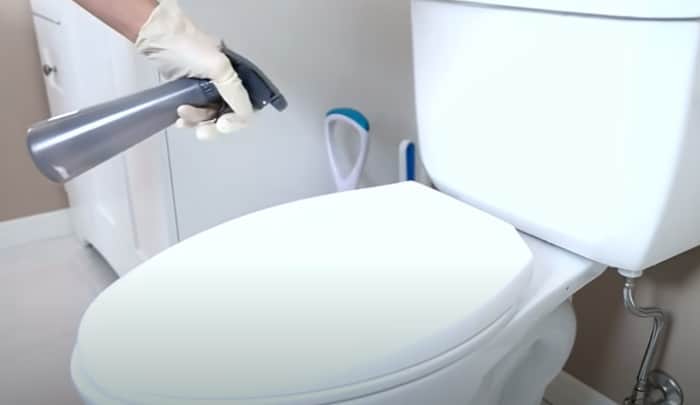
“While numerous commercial products can remove yellow stains from toilets, several household items can work just as well, if not better. For instance, vinegar, combined with baking soda, creates a potent cleaner that can be used to effectively scrub away even stubborn stains. However, it’s crucial to remember that consistency, patience, and a bit of elbow grease are equally as important as the solution used. The effectiveness of the cleaning process is determined not just by the products, but also by your commitment to a regular cleaning schedule.”
Kester Davenport, Certified Cleaning Consultant
Where Do Yellow Stains On A Toilet Seat Come From?
There are quite a few reasons why yellow stains appear on the toilet seat. However, the vast majority of yellow stains are caused by two issues: Urine and hard water. These are most common types of toilet stains in toilet bowls.
Urine is the obvious culprit for yellow stains on a toilet seat. Urine contains a yellow chemical known as urochrome or urobilin, which tints urine yellow. This is why it’s crucial to clean your bathtub regularly as well, as these stains can affect various bathroom surfaces stains on a toilet seat. Urine contains a yellow chemical known as urochrome or urobilin, which tints urine yellow.
Yellow stains caused by urine are usually due to urine being left on or in the toilet for an extended period of time without cleaning. If left unchecked for 92 hours, urochrome can produce damaging stains. Areas that don’t get sunlight develop these problems even faster. Take into consideration all these factors for your cleaning routine.
The best way to remove yellow stains from a toilet is to soak it in 2 cups of vinegar with a concentration of 8% acetic acid for 20 minutes and then proceed to use a baking soda mix to complete the cleaning.
Sometimes, water isn’t enough to remove all the yellow colorant in urine from your toilet seat, which is why using proper soaps is important during your toilet cleaning. This principle applies to other bathroom surfaces too, such as when you need to clean shower tiles without scrubbing. When urine traces are left on the toilet seat for too long, it’ll get into the plastics and turn them yellow, and could even develop odors. At that stage, it is difficult to deal with and remove. This might become a bigger problem.
A less known culprit of yellow stains and spots is hard water. Hard water contains minerals such as iron, calcium, and magnesium. These minerals in hard water can stick onto surfaces in your bathroom and cause them to yellow over time. In some cases, you may even need to remove rust stains from tiles due to mineral buildup. It will take less than 24 hours for hard water to visibly mark a toilet. This can happen to not just toilet seats, but sinks as well!
These are some tips that can help you to get rid of yellow stains and other problems like grime, water stains and filth. Choose a method that can help with other issues like gunk and stench.
Using Vinegar and Baking Soda
This is the time-tested home remedy to removing yellow stains from your toilet seat and is one of the first methods that you should try. Vinegar is excellent at removing long-standing muddy stains and is ideal for tackling those nasty yellow ones. It is something that you can get in any store.
The reason vinegar works is because of it’s acidity so you’ll want to get strong, undiluted vinegar for it to work best. Vinegar is among the most versatile products.
First, you will want to soak some vinegar in the stained area of the toilet, and use a brush to work in the vinegar. Ideally, you will want to do the whole toilet just to be sure. Leave it to sit and do its magic for at least 20 minutes. If you want to avoid using vinegar, just replace it with lemon juice.
To make a paste with the following ingredients, mix two cups of vinegar with three tablespoons of baking soda. You will apply this paste onto the toilet seat and the bowl, making sure to fully cover the yellow stains. After letting the vinegar sit, you must use a toilet brush or sponge to scrub the area from residue.
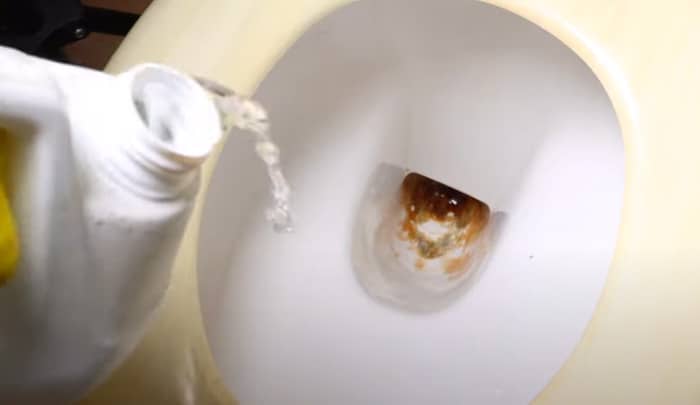
Using Bleach
If the stains are difficult to remove, we might want to consider using some bleach. Bleach shouldn’t be used unless you have to, as it is quite corrosive. Before you begin cleaning, It is crucial that you take precautions such as wearing gloves and ventilating your bathroom properly, the place has to be well prepared. Bleach is great for rotten material and stinky odors.
Fill 1/3 of a cup with bleach and apply it to the bowl, scrub the areas with a brush. Make sure that the stain disappears while scrubbing. After that, mix bleach once again this time with water, and clean the whole toilet. Cleaning the toilet with bleach is faster and takes 5-10 minutes. Watch out for weird smells and fumes, bleach occasionally reacts with matter contained in the septic deposit.
Using Vinegar or Apple Cider Vinegar Alone
If you don’t have any baking soda, you can still use white vinegar or even apple cider vinegar (ACV) on its own to get those grubby stains out. You will want to soak a cloth in white vinegar and then use that saturated cloth to cover the stained area. Let the cloth sit on the stained area for 120 minutes. After that, you can remove the cloth and then begin to scrub that area down with a toilet brush and continue to apply vinegar over the stain while you brush. Once the yellow stains are gone, you will want to rinse the area with water and apply disinfectant.
Using commercial cleaners
There are plenty of commercial cleaners that are specifically designed to remove these colored stains from your toilets. We highly recommend using Borax, Clorox Toilet Bowl Cleaner with Bleach, which is great for working into the stains and removing them with relative ease. If you are feeling daring, you can use a bottle of coke to treat the stains. A coca-cola can replace a lot of cleaning products.
Testing and Comparing Cleaning Methods
- We discovered that the vinegar solution & baking soda method was the easiest and took the least effort, taking only 5 minutes of work. The end result was an impressive 9/10.
- The commercial cleaners were equally as effective and came with useful bottle shapes which allowed us to easily apply the solution. They took approximately 5 minutes of work as well. The only downside is that they are costly. We rate it a 9/10
- The bleach method took the longest as we had to apply & scrub regularly, taking approximately 15 minutes of total work. This is the worst result, 7/10.
Preventing the Return of Yellow Stains
In order to prevent yellow stains from returning, you will need to clean your toilet every 14 days so that any stains are not left on for a prolonged period of time. Ensuring that you flush after every use is also very important to faster results. Double check your method because some people might have allergic reactions to some these chemicals.
Avoiding harsh chemicals will keep your toilet from developing damage, which liquids like urine and hard water can seep into and develop yellow stains. When they seep into the material itself, removing yellow color stains from any surface becomes very difficult to do. You may also want to consider switching the water line if you find that the hard water is causing yellow stains and using a reliable mold prevention chemical.
Keep your toilet bowl clean with these solutions
By maintaining a regular toilet cleaning routine, you can always prevent a buildup of these yellow stains and remove them before they become embedded into the toilet. The longer these stains are left on the toilet, the more difficult they become to remove. You don’t need expensive commercial cleaners to remove these stains, either, as home remedies have been proven to work astoundingly well at getting those yellow stains off. One more tip, using a spray bottle will make it easier.
Make sure that you avoid using overly-harsh chemicals that can turn your toilet seats brittle and prone to damage so that there is less of a chance that muck, urine and hard water can get trapped inside the toilet seat.
A clean toilet bowl is like a full tank of gas in your car, you’ll appreciate it when you have to use it at a moment’s notice.
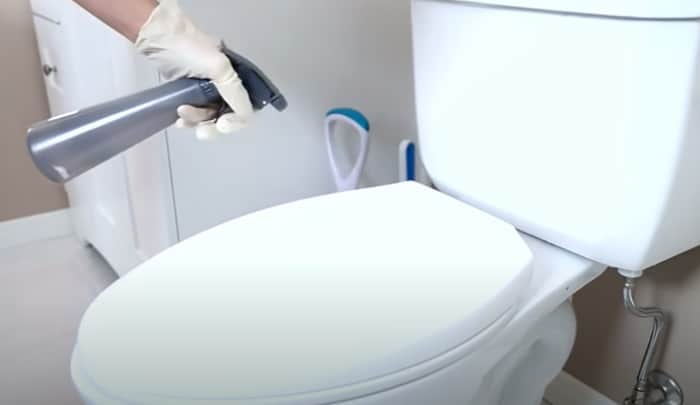

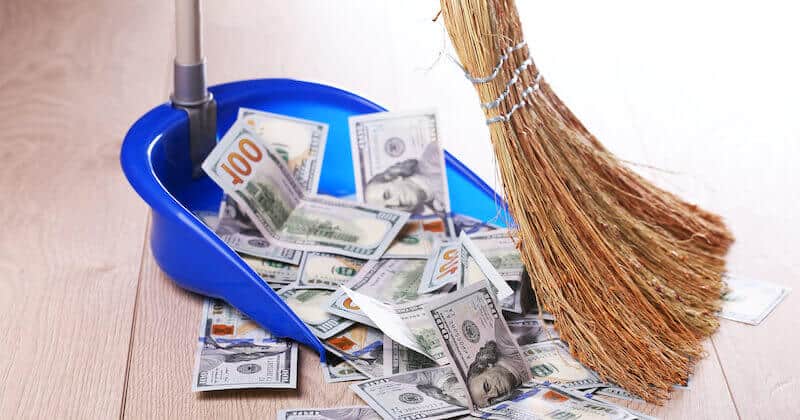
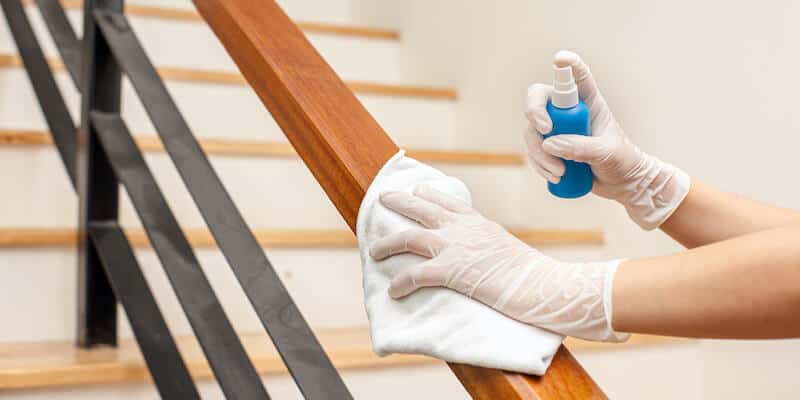
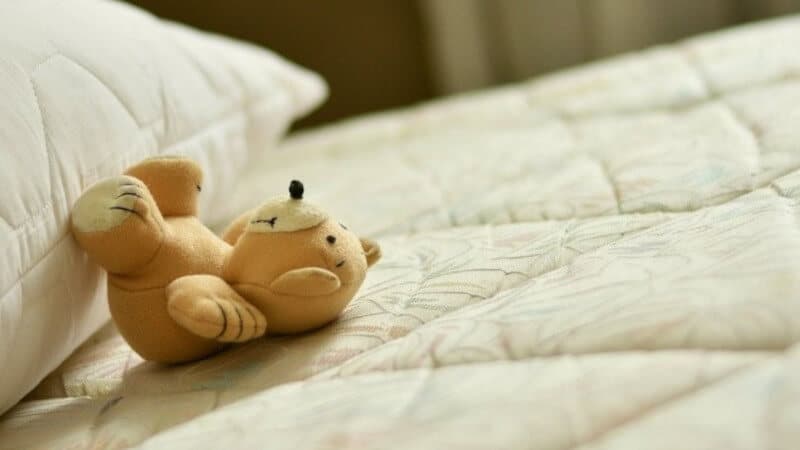

Using a paste of baking soda and vinegar has always served well in removing stubborn yellow stains from my toilet seat.
While the baking soda and vinegar paste can be effective, I have found a magic eraser or a pumice stone works wonders on these yellow stains. The abrasive surface of the pumice helps in scraping away the stain without damaging the seat. The key to success is gentle scrubbing and a patient approach to not wear down the toilet seat.
While I respect the idea of using pumice stone’s abrasive surface, one must consider that its overuse can lead to micro-scratches, which act as a safe haven for bacteria! In my experience, regular deep-cleaning with non-abrasive cleaners is safer and more effective in the long run.
While Quentin’s concerns about micro-scratches are valid, it’s also important to remember that most bathroom cleaners contain chemicals that can damage our skin and respiratory system. I’ve found that natural solutions such as vinegar and baking soda work well when stubborn stains need tackling without compromising safety or hygiene.
I agree with your observations, Penrose. I too have used vinegar and baking soda to clear out stubborn stains in my toilet. What’s more economical and safer than items you already have in your pantry? Just remember not to mix it with chlorine bleach if you’re trying this out for the first time as it can produce harmful gas.
Quincy, I just wanted to add that you’re absolutely spot-on about not mixing vinegar and baking soda with chlorine bleach. Not many people know about this dangerous combination. However, another safe alternative that worked well for me was using borax and lemon juice – it did wonders on yellow stains!
Agreed, Jensen! The combination of borax and lemon juice is indeed a hidden treasure in the world of cleaning; I’ve used it plenty during my tenure as a school janitor.